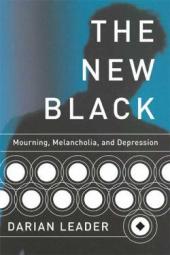
The New Black: Mourning, Melancholia, and Depression
by Darian Leader
–Reviewed by Shahnaz Habib
 What came first – depression or anti-depressants? Darian Leader’s The New Black begins by providing a context for the pervasiveness of depression. While it will surprise no one that the pharmaceutical industry has helped manipulate depression into its current status as the largest public health problem after heart disease, Leader develops this argument into a comprehensive case for reviving the Freudian concepts of mourning and melancholia.
What came first – depression or anti-depressants? Darian Leader’s The New Black begins by providing a context for the pervasiveness of depression. While it will surprise no one that the pharmaceutical industry has helped manipulate depression into its current status as the largest public health problem after heart disease, Leader develops this argument into a comprehensive case for reviving the Freudian concepts of mourning and melancholia.
In 1915, Freud wrote a brief essay in which he drew links between melancholia and mourning and the experience of loss. Mourning, according to Freud, was the process by which the grieving person detached their memories and aspirations from the person they lost. The mourner painfully catalogues mental and physical elements – the expectation that when the phone rings it will be the loved one at the other end, for example – and eventually recognizes, if the mourning goes well, that life will go on without the person they lost. The melancholic, on the other hand, is not able to distinguish what he has lost, and he reproaches himself for it. This lowering of self-regard is central to the melancholic’s identity.
Drawing on these definitions, and using illustrations from psychoanalytic case files as well as art and literature, Leader establishes how varied the forms of mourning and melancholia can be, especially at different stages. A young woman is haunted by the image of the sweetshop where her dead mother used to work. Joan Didion begins The Year of Magical Thinking with four italicized lines that recur again and again, like a nursery rhyme. John Cleese in his memorial speech for Graham Chapman called him a freeloading bastard. Leader also speaks of anniversary reactions, when the mourner develops physical symptoms or intense depression annually on the date of their loss, without being aware of the connection. Mysterious indeed are the ways in which we process grief, yet our mental health treatments are built on “dubious biochemistry” and “shallow psychology’ that reduce complex and unconscious interior lives to their surface symptoms.
As with the individual, so with the larger society. Leader traces the loss of public mourning rituals to the beginning of the First World War and the impossibility of mourning the large numbers of the dead. A society that cannot mourn its dead is a society that does not understand loss. It is ripe for hysteric and irrational consummations of grief, such as the violent television dramas we watch or the outpouring of grief in the wake of Michael Jackson’s death.
Can Freud explain everything? The New Black does not have anything to say about non-Freudian perspectives to understand depression, such as recent studies on the mental health impact of meditation. However The New Black is a sign – the first sparrow of spring – that a less dogmatic, more diverse understanding of mental health is on its way. Leader himself recognizes that psychoanalysis is not accessible to everyone – his solution, again going back to Freud, lies in the curative powers of making art.
While the book calls for an overhaul of the current systems of depression diagnosis and treatment, it is also a call for small rebellions. The New Black emphasizes that in grief, as in our fingerprints, we are unique. It leaves the reader with a sense of human frailty, of the spider-web-tenuous connections that keeps us anchored as social beings. Happiness and sadness, Leader suggests, are not such watertight compartments as they seem.
Excerpt: “The force of Freud’s argument here is to show that we can die before our biological death, as we turn to inhabit the world of the dead or departed. The lost loved one is then never relinquished. When clinicians receive patients who seem desolate or dejected, it is always crucial to explore in the greatest detail the history and context of the surface depression. … This may be a response not only to a real bereavement, but to the loss of a lover, a friend, or even a political or religious ideal.”
Further Reading: An Unquiet Mind: A Memoir of Moods and Madness and Bright-sided: How the Relentless Promotion of Positive Thinking Has Undermined America
Shahnaz Habib is a freelance writer based in Brooklyn.
*Photo courtesy ashley rose.




Send A Letter To the Editors